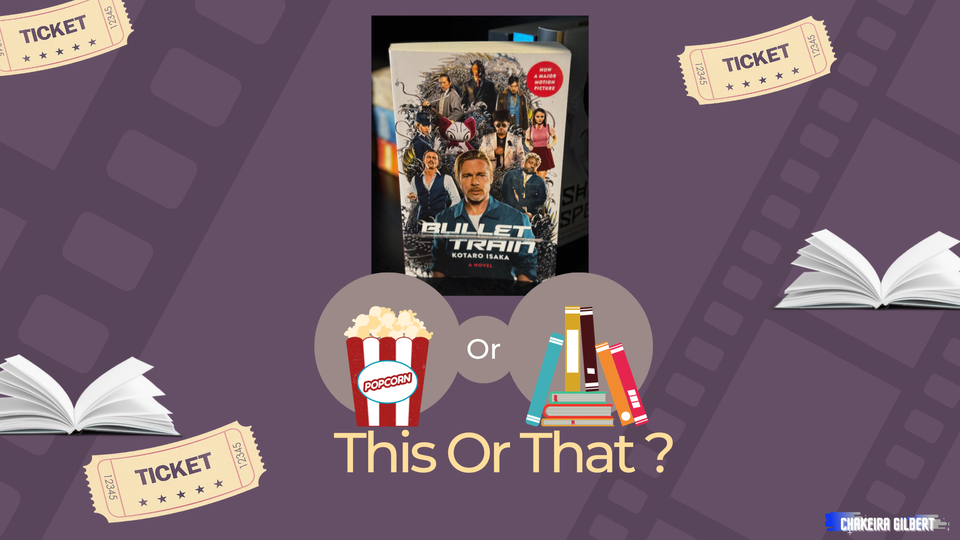Bullet Train: Movie vs. Book

Introduction
Bullet Train is an action-packed mystery thriller set on a bullet train for most of the story. It follows various perspectives, such as Ladybug, The Prince, Fruit, and Kimura. The book, written by Kotaro Isaka and translated by Sam Malissa, was adapted by Netflix and directed by David Leitch during the Summer of 2023. Both the book and the movie are quirky and fast-paced. However, there are some differences between the source material and the adaptation. In this article, I will discuss the differences and what changes I liked and disliked. If you want to read or watch Bullet Train, please feel free to return to this later, as it will have spoilers.
Comparison
The White Death character was added to the movie adaptation as he was not in the book. He was added for two reasons: 1. to have a central villain that orchestrates everyone getting on the train and 2. to adjust the ending and The Prince's storyline. I don't necessarily fault the movie creators for wanting the villain to have a more significant role in the story; however, with the addition of the White Death, we lose some of the character motivations found in the book, and the characterization is not as strong. The mob boss, Minegishi, is a minor character in the book, but the movie has the White Death kill him. White Death is an unnecessary character, in my opinion.
In the movie, The Prince is a teenage girl who is manipulative, cunning, and cruel, but ultimately, her storyline is to get White Death's attention because she believes she should be his heir and not her brother. Because there are so many men in the movie, her storyline is rooted in sexism, as she is overlooked by her father only because she is a girl. The movie did not do a good job of really building her as a character. I walked away, saying this girl has daddy issues. The Prince was also a teenager in the book, but we got more of his storyline. The movie keeps all of his traits except that he is a psychopath. The viewer doesn't get that until the end of the movie. In the book, The Prince was compelled to face a bigger challenge. He wanted to meet his match because terrorizing school kids had become too easy, and Minegishi didn't take him seriously. I enjoyed The Prince better in the book. He was used to show both depravity and humanity in an intriguing way.
The Wolf is a minor character in the book and a minor character in the movie, as his main job is to prevent Ladybug from getting off the train. Except in the movie, we got a backstory of why he wants revenge on Ladybug. The Wolf had motivations for revenge in both the book and movie, but the book did a better job of laying out why he had the vendetta. I did not like the drug dealer stereotype in the movie, and honestly, I'm not sure why they changed the backstory. It was too long of a flashback.
The movie is set in Japan, yet 99% of the characters are white. While articles have stated the author doesn't mind the absence of Japanese actors, I can literally count the number of people of color on one hand, and 2 of them included stereotypes. Above, I talked about The Wolf, but The Elder was another stereotype. In the movie and the book, he is Kimura's father. He doesn't have the same impact as in the book. The movie doesn't even include his wife. The stereotype used for The Elder is that he is a samurai. He has to use a sword in the fight scenes even if everyone else, up to that point, was using guns and ordinary objects found on the train. However, that wasn't present in the book.
Lesson Learned
Bullet Train, the movie, taught me nothing. This action movie is easily forgettable after watching another action movie. Before writing this, I rewatched the movie to remember the details. However, I have thought about the book periodically. Maybe it is because I started this book in early November 2023, and we all know what is happening in the world. The theme of luck contrasts heavily with the theme of conformity. Everyone in this story is a villain; everyone has an angle. There are no good guys, but you root for Ladybug even though he is just another assassin on the train. The Prince keeps asking these characters why it is bad to kill someone, and everyone's answer is pretty trite except one. By the time you get to this portion of the book, you aren't worried the Prince is a schoolboy; you want him to be brought down a notch.
The author does a good job of sprinkling in discussions regarding morality. The Prince and Ladybug seem lucky throughout the story, but this random teacher's answer about why killing is wrong made me think more about conformity and not morality. It connected back to an earlier instance on state-sanctioned killings that caught my attention. This idea of conformity stuck with me because we see it play out in real life. Conformity is more economical to those who hold power. The morality of a decision is not considered; what is considered is how it will affect money and, in turn, power. So we see The Prince as lucky because he holds the power to get those around him to conform to what he wants, but then brings up morality when he doesn't have that power.
Conclusion
The movie is more comedic than the book, and everyone is more connected. However, even with those connections, the book did a better job of delving into the characters and their motivations. In the book, I felt like I got to understand the characters. The movie was over-the-top in a lot of ways. While both explored the themes of luck, conformity, and morality, the book did it better. The movie crossed over into absurd too much to get anything but a laugh out of me. The movie is something to watch when nothing else is on, and you don't want to use your brain too much. The book has stayed with me and prompted me to pick up the author's other translated work.
If you need some recommendations, check out my Goodreads or StoryGraph. Then, follow me on Instagram and Twitter. One of my favorite newsletters to read for current events is Morning Brew. Check it out.
